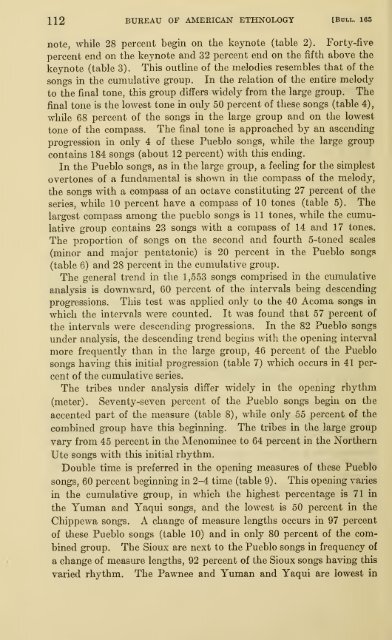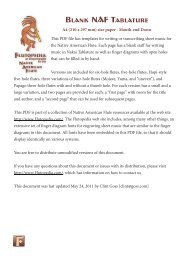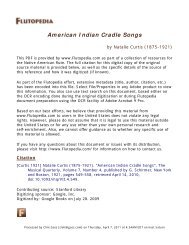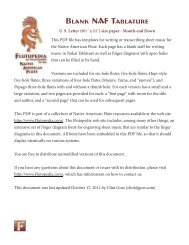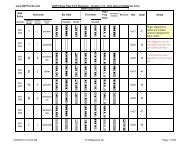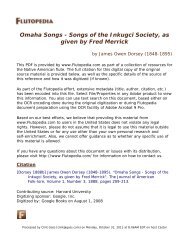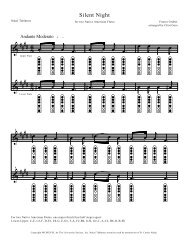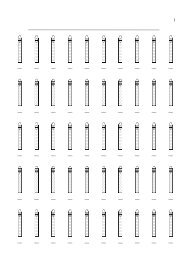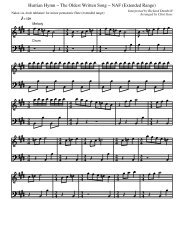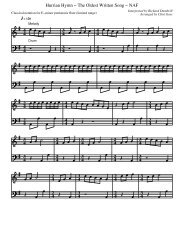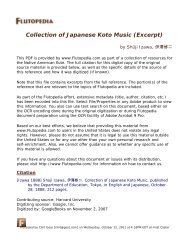Music of Acoma, Isleta, Cochiti, and Zuñi Pueblos - Flutopedia.com
Music of Acoma, Isleta, Cochiti, and Zuñi Pueblos - Flutopedia.com
Music of Acoma, Isleta, Cochiti, and Zuñi Pueblos - Flutopedia.com
Create successful ePaper yourself
Turn your PDF publications into a flip-book with our unique Google optimized e-Paper software.
112 BUREAU OF AMERICAN ETHNOLOGY [Bull. 165<br />
note, while 28 percent begin on the keynote (table 2). Forty-five<br />
percent end on the keynote <strong>and</strong> 32 percent end on the fifth above the<br />
keynote (table 3). This outlme <strong>of</strong> the melodies resembles that <strong>of</strong> the<br />
songs in the cumulative group. In the relation <strong>of</strong> the entire melody<br />
to the final tone, this group differs widely from the large group. The<br />
final tone is the lowest tone in only 50 percent <strong>of</strong> these songs (table 4),<br />
while 68 percent <strong>of</strong> the songs in<br />
the large group <strong>and</strong> on the lowest<br />
tone <strong>of</strong> the <strong>com</strong>pass. The final tone is approached by an ascending<br />
progression in only 4 <strong>of</strong> these Pueblo songs, while the large group<br />
contains 184 songs (about 12 percent) with this ending.<br />
In the Pueblo songs, as in the large group, a feeling for the simplest<br />
overtones <strong>of</strong> a fundamental is sho^vn in the <strong>com</strong>pass <strong>of</strong> the melody,<br />
the songs with a <strong>com</strong>pass <strong>of</strong> an octave constituting 27 percent <strong>of</strong> the<br />
series, while 10 percent have a <strong>com</strong>pass <strong>of</strong> 10 tones (table 5). The<br />
largest <strong>com</strong>pass among the pueblo songs is 11 tones, while the cumulative<br />
group contains 23 songs with a <strong>com</strong>pass <strong>of</strong> 14 <strong>and</strong> 17 tones.<br />
The proportion <strong>of</strong> songs on the second <strong>and</strong> fourth 5-toned scales<br />
(minor <strong>and</strong> major pentatonic) is 20 percent in the Pueblo songs<br />
(table 6) <strong>and</strong> 28 percent in the cumulative group.<br />
The general trend in the 1,553 songs <strong>com</strong>prised in the cumulative<br />
analysis is downward, 60 percent <strong>of</strong> the intervals being descending<br />
progressions. This test was applied only to the 40 <strong>A<strong>com</strong>a</strong> songs in<br />
which the intervals were counted. It was found that 57 percent <strong>of</strong><br />
the intervals were descending progressions. In the 82 Pueblo songs<br />
under analysis, the descending trend begins with the opening interval<br />
more frequently than in the large group, 46 percent <strong>of</strong> the Pueblo<br />
songs having this initial progression (table 7) which occurs in 41 percent<br />
<strong>of</strong> the cumulative series.<br />
The tribes under analysis differ widely in the opening rhythm<br />
(meter). Seventy-seven percent <strong>of</strong> the Pueblo songs begin on the<br />
accented part <strong>of</strong> the measure (table 8), while only 55 percent <strong>of</strong> the<br />
<strong>com</strong>bined group have this beginning. The tribes in the large group<br />
vary from 45 percent in the Menominee to 64 percent in the Northern<br />
Ute songs with this initial rhythm.<br />
Double time is preferred in the opening measures <strong>of</strong> these Pueblo<br />
songs, 60 percent beginning in 2-4 time (table 9) .<br />
This opening varies<br />
in the cumulative group, in which the highest percentage is 71 in<br />
the Yuman <strong>and</strong> Yaqui songs, <strong>and</strong> the lowest is 50 percent in the<br />
Chippewa songs.<br />
A change <strong>of</strong> measure lengths occm-s in 97 percent<br />
<strong>of</strong> these Pueblo songs (table 10) <strong>and</strong> in only 80 percent <strong>of</strong> the <strong>com</strong>bined<br />
group. The Sioux are next to the Pueblo songs in frequency <strong>of</strong><br />
a change <strong>of</strong> measure lengths, 92 percent <strong>of</strong> the Sioux songs having this<br />
varied rhythm. The Pawnee <strong>and</strong> Yuman <strong>and</strong> Yaqui are lowest in


